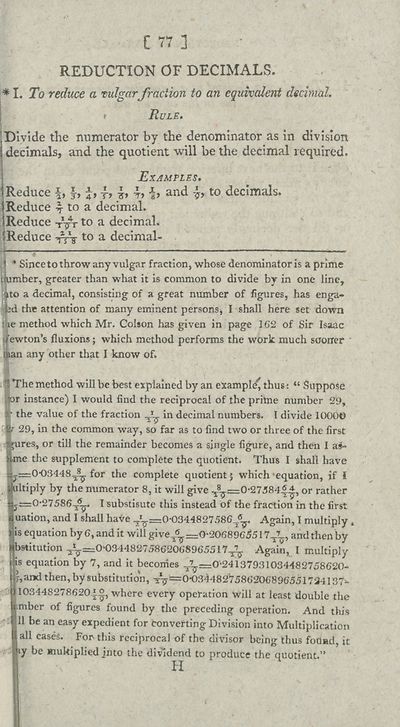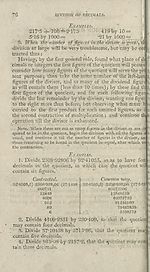Download files
Complete book:
Individual page:
Thumbnail gallery: Grid view | List view

REDUCTION OF DECIMALS.
* I. To reduce a vulgar fraction to an equivalent decimal.
■ Rule.
Divide the numerator by the denominator as in division
decimals, and the quotient will be the decimal required.
Examples.
Reduce §•, 4> i» and to decimals.
Reduce 4 to a decimal.
Reduce tVt o a decimal.
Reduce to a decimal-
* Since to throw any vulgar fraction, whose denominator is a prime
umber, greater than what it is common to divide by in one line,
j to a decimal, consisting of a great number of figures, has enga-
;d the attention of many eminent persons, I shall here set down
| ie method which Mr. Colson has given in page 162 of Sir Isaac
ewton’s fluxions; which method performs the work much sooner
an any other that I know of.
■ The method will be best explained by an example^ thus: “ Suppose
|or instance) I would find the reciprocal of the pritne number 2‘9,
r the value of the fraction ^ in decimal numbers. I divide 1000©
r 29, in the common way, so far as to find two or three of the first
pires, or till the remainder becomes a single figure, and then I a$-
me the supplement to complete the quotient. Thus I shall have
?=0O3448t87 for the complete quotient; which 'equation, if 1
ultiply by the numerator 8, it will give ^=0-27J84«^ or rather
ys=0'27586-^. Isubstisute this instead of the fraction in the first
nation, and I shall have ^=0-0344827586^. Again, I multiply.
is equation by 6, and it will give/^ =0-2068965517^, and then by
rtitution-^=04)3448275862068965517^ Again, I multiply
equation by 7, and it becomes ^=0-24137931034482758620-
r,and then, by substitution, Ar=0-O3448275862O6896551734137-
1103448278620-1°, where every operation Will at least double the
mber of figures found by the preceding operation. And this
11 be an easy expedient for converting Division into Multiplication
all cases. For this reciprocal of the divisor being thus fotiad, it
iy be multiplied into the dividend to produce the quotient.”
* I. To reduce a vulgar fraction to an equivalent decimal.
■ Rule.
Divide the numerator by the denominator as in division
decimals, and the quotient will be the decimal required.
Examples.
Reduce §•, 4> i» and to decimals.
Reduce 4 to a decimal.
Reduce tVt o a decimal.
Reduce to a decimal-
* Since to throw any vulgar fraction, whose denominator is a prime
umber, greater than what it is common to divide by in one line,
j to a decimal, consisting of a great number of figures, has enga-
;d the attention of many eminent persons, I shall here set down
| ie method which Mr. Colson has given in page 162 of Sir Isaac
ewton’s fluxions; which method performs the work much sooner
an any other that I know of.
■ The method will be best explained by an example^ thus: “ Suppose
|or instance) I would find the reciprocal of the pritne number 2‘9,
r the value of the fraction ^ in decimal numbers. I divide 1000©
r 29, in the common way, so far as to find two or three of the first
pires, or till the remainder becomes a single figure, and then I a$-
me the supplement to complete the quotient. Thus I shall have
?=0O3448t87 for the complete quotient; which 'equation, if 1
ultiply by the numerator 8, it will give ^=0-27J84«^ or rather
ys=0'27586-^. Isubstisute this instead of the fraction in the first
nation, and I shall have ^=0-0344827586^. Again, I multiply.
is equation by 6, and it will give/^ =0-2068965517^, and then by
rtitution-^=04)3448275862068965517^ Again, I multiply
equation by 7, and it becomes ^=0-24137931034482758620-
r,and then, by substitution, Ar=0-O3448275862O6896551734137-
1103448278620-1°, where every operation Will at least double the
mber of figures found by the preceding operation. And this
11 be an easy expedient for converting Division into Multiplication
all cases. For this reciprocal of the divisor being thus fotiad, it
iy be multiplied into the dividend to produce the quotient.”
Set display mode to:
![]() Universal Viewer |
Universal Viewer | ![]() Mirador |
Large image | Transcription
Mirador |
Large image | Transcription
| Antiquarian books of Scotland > Education > Complete treatise on practical arithmetic and book-keeping > (91) |
|---|
| Permanent URL | https://digital.nls.uk/114434662 |
|---|
| Description | Thousands of printed books from the Antiquarian Books of Scotland collection which dates from 1641 to the 1980s. The collection consists of 14,800 books which were published in Scotland or have a Scottish connection, e.g. through the author, printer or owner. Subjects covered include sport, education, diseases, adventure, occupations, Jacobites, politics and religion. Among the 29 languages represented are English, Gaelic, Italian, French, Russian and Swedish. |
|---|

